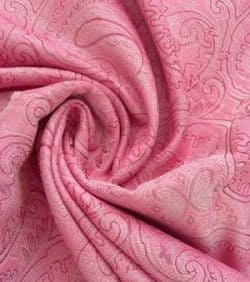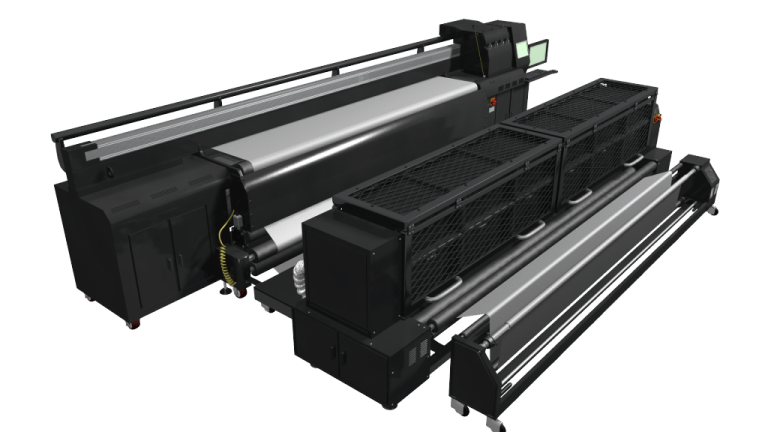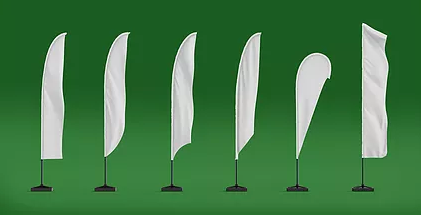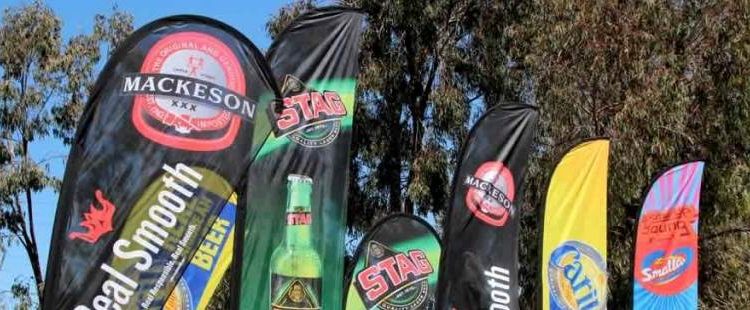Polyester is a fabric that is a polymer-based material made of PET, or polyethylene terephthalate.
What is Polyester?
Some polyesters are plant-based from naturally occurring chemicals, although they are in the minority. Some of these naturally occurring polyesters, and a few synthetic ones such as polybutyrate, are biodegradable, but most are not.
Some polyesters are “thermoplastics,” and these are the type used in polyester fabric.
Polyester fabrics are used extensively in the apparel industry, furniture manufacturing, bedding – sheets, blankets, and coverings – as well as in the graphic advertising universe.
The fiber is also used in ropes, tire reinforcing, conveyor belts, seat belts, and coated fabrics. Other items that can be made with PET are tarps, bottles, LCD displays, holograms, insulating tape, filters, canoes, films for capacitors, films, wire insulation, etc. Polyesters can be used in high quality wood finishing on pianos and guitars and the interiors of cars and trucks. It has the ability to be used as a filler in porous woods such as Oak or Mahogany. It is sandable and polishable and finally, durable.
 Polyester fabric is very stain resistant, and only certain specialty dyes are able to permanently color the fabric. These dyes are used in combination with heat and pressure to print designs or commercial graphics on this material. You may have seen this fabric used in front of your favorite fast food restaurant on flab banner poles.
Polyester fabric is very stain resistant, and only certain specialty dyes are able to permanently color the fabric. These dyes are used in combination with heat and pressure to print designs or commercial graphics on this material. You may have seen this fabric used in front of your favorite fast food restaurant on flab banner poles.
Polyester can be “blended” or spun with natural fibers, such as cotton, to create a fabric that is wrinkle free, rip resistant, and won’t shrink in the washer and dryer like cotton will on it’s own. Polyester, blended with cotton or other natural fibers, will also be resistant to molds and mildews better than just a natural fiber like cotton or linen.
The one negative is that poly-fabrics are susceptible to flame more than other fabrics, although due to the lightweight nature of the fabric, it would be unlikely to add much fuel to an already burning fire.
Polyesters have also been made to mirror natural fibers. An example is “polysilk” fiber, obviously mimicking silk. Polyknits have been used for 50+ years, but now can emulate cotton or wool or taffeta or other natural or synthetic fibers, often with superior durability.
All in all, polyesters are a miracle of science, and life as you know it would go backwards 75 years without it.
Will Polyester Shrink?
Yes and no. If you put a polyester shirt or banner or whatever in the washer on hot, and the dryer on high heat, no. Polyester is susceptible to heat, but greater than what it would typically encounter in either washer or dryer, especially if you have a dryer that automatically shuts off once it senses that most of the moisture has been dispelled. This would mean that the fabric never gets really hot and dry. So, if you don’t overheat it in your dryer, there’s not much to worry about.
So, what will make polyester shrink? If you’ve read any of my articles on dye sublimation printing, you know that a brief exposure to heat and pressure – in order to transfer a CMYO image from a transfer sheet to polyester fabric – not only doesn’t shrink, it creates stunning continuous tone graphics, unlike the dot resolution of a digital printer.
What kind of heat will shrink polyester? Prolonged heat is more likely to cause at least some shrinkage. Could your dryer shrink a flag banner? Sure, but you’d really have to work at it.
What are the Benefits of the Poly-rich Blends
In a sense, we’ve already answered this question in regards to fabrics that are “enriched” with polyester, such as cotton. Risking too much repetition, a 50/50 cotton tee-shirt is really a 50/50 cotton polyester tee-shirt. In the realm of polyester flag banners, cotton is not a necessity and would likely be a liability, as it is very comfortable to wear, but would not be as durable as 100% polyester fabric.
Polyester Flag Banner Printing
What is “Dye Sublimation Printing” and how long is the production time?
First, let me say, thank you for asking me about my personal favorite product and topic!
Second, let me say that this is really two distinct questions, so I’m going to parse it out as if it were two questions, but in paragraph form…actually, multiple paragraph form but with a notice that I’m answering the second part of the question on “how long is production time.”
Dye sublimation printing is a process of creating a graphic, art, or copy, or all three, onto a sheet of polyester fabric. Yes, I realize I just gave you a cliché answer, but be patient, as I am going to explain precisely what that entails.

First, if you’re familiar with ink sets, you likely know that in digital printing – direct to fabric or substrate – that you would use a CMYK color set to produce a 4CP (four color process, or full color) print on anything from static cling decals to corrugated plastic to vinyl or cloth fabric banners (the latter, IMO, is inferior to dye sub printing on polyester banner material).
However, with dye sublimation printing, someone way smarter than me had a revelation, a vision as it were, to print an image on a thermal transfer paper, using not the standard CMYK print colors, but rather to print a CMYO dye set, which stands for CyanMagentaYellowClear. Who even comes up with this stuff?!
Regardless of who, how, or why, the most awesome printing category of all time was conceived of by said genius, using dye, heat, and pressure, I won’t bother going into heat and pressure and why he or she was able to decide to use the heretofore unknown CYMO dye set, printing it onto paper, affixing it to a PET fabric, and sending it through 400F (205C) rollers at 400 lbs. pressure to create beautiful continuous tone prints, but whatever, it worked!
As far as production time (I am now introducing the 2nd part of the question in case you, dear reader, missed it), it takes a bit longer than a straight digital to substrate print because you have to marry the print substrate, a.k.a. the transfer paper, to the fabric, then carefully, so as to avoid wrinkling, feed it through the pressurized heated rollers.
I’d say if you are creating a 4ft. by 8ft. banner using dye sublimation printing, it might consume half an hour. Of course, if you have 10 copies of that banner, it might only take an hour, which is why we offer, in our industry, quantity discounts. Not because we’re nice, mind you, but because our competitors do!
How many colors can be reproduced using dye sublimation?
Let me answer that question by asking you a question. How many colors are there in the CYMK or CYMO color spectrum? I don’t know either, but the sky is the limit. We have artists who trust us to print their paintings, photographers who trust us to render their photography, and commercial artists with very small amounts of commercially shameless artistic ability to print their designs. We are able to imitate real life in full color, and in a superior way to virtually any other type of printing.
Is dye sublimation used for four color process only?
This is easier to answer than the previous question. The answer is: read the previous answer. If we can print full color, we can also print black and white. Actually, that was a fake question as no one would actually ask that question, would they? I didn’t think so…I think my secretary slipped it in. Fake news, fake question!
Polyester Flags versus Other Substrates
Are heavy-weight nylon and polyester flags comparable in durability?
While nylon, for instance, can be printed, it cannot be printed using dye sublimation printing. Durability as a fabric? I’m not sure on that, but as a user of both, I would say this is an apples to oranges comparison, although I have found in my personal experience that they’re pretty close to even, albeit with many different usages from each other.
What is the difference between knitted polyester, woven and fully sewn flags?
All polyester fabric is woven, and “knitted” is a misnomer which gives one a picture of grandma on the couch with knitting needles. “Fully sewn” is also misleading, as it means any hems are sewn, not woven or hot-knife finished.
What is a life span of knitted polyester, woven and fully sewn flags?
It varies. How is the flag secured. Where is it secured? What are the wind and sun weather conditions in the area the flags will be used? Sun and wind are the enemies of all banners and their installations, but on flags, if secured over a pole, wind is less a factor than the sun will be.
However, a flag on a pole, like a country or state flag, has an average life of 6 to 12 months. A banner flag tacked to a wall may last years, though, as the wind will have little affect. On the north side of a building, this banner may last five or ten years. On the south side, west side, or east side, the sun will reduce that banner flag’s longevity, maybe up to 50% or more.
Why choose fabric over vinyl?
In a word, “classiness.” Is that even a word? Regardless, would you rather wear a lovely dress, or a piece of vinyl? Personally, I’d wear a soft hand fabric dress any day, although my wife might take umbrage at my wearing the dress.
Vinyl looks like, well, vinyl. Cloth Fabric Banners look natural, not like a platinum blonde with a nose job and fake eye lashes. Simply put, they look natural, not fake, like the aforementioned platinum blonde!
Materials for Making Flag Banners
Why are flags made out of different materials?
Cost. Not everyone wants to pay for a polyester flag when a cheaper nylon flag saves a few dollars, or a cotton flag will be used indoors, so the longevity of polyester is not a factor.
What are the pros and cons to each flag material?
- Polyester – none to speak of.
- Nylon – typically lighter weight than either cotton or polyester, but still usable both indoors and out-of-doors.
- Cotton – better for indoor use, outdoors, not so much.
Why is a lighter flag better?
Who said a lighter flag is better? Well, in some circumstances maybe so…maybe your marionettes from your school want to carry a big ole US flag in the Memorial Day parade…nylon is a bit lighter, so rest those tired arms with a nylon flag!
What is the best material and construction for flags flown year round outdoors?
Polyester, hands down, is the best material for flags. It is a bit higher in up front cost, but over time will prove less costly.
What is the best material and construction for flags used indoors?
Nylon. Cheaper and lighter weight and the sun, wind, and rain won’t bother it inside.
What is the most durable material for outdoor flags where there is lots of wind?
A bit of a redundant question, but polyester is the best material for this usage. Again, however, if flown on a standard flag pole, like a US flag is, the wind will shred the flag over time. In high wind areas, we estimate a maximum life of 6 months, and 12 months in a moderate wind area. There are no warranties offered by anyone in these conditions that I’m aware of.
Grommet versus Pole Hem
What is a standard flag with grommets?
If it’s a flag flown on a pole, like your national flag, it will have a grommet in two corners on the side of the flag that hangs from the snap hooks on the lanyard.
If it’s attached to a wall or similar, it will have grommets in the corners at the very least, and maybe a few more top and bottom.
What is a standard flag with pole hem?
 On a pole banner, such as a flag banner, tear drop banner, or feather banner, the pole fits into a sleeve sewn into one edge of the fabric at the factory. Templates are provided that show where the sleeve is so that you don’t place your graphics over top of the sleeve.
On a pole banner, such as a flag banner, tear drop banner, or feather banner, the pole fits into a sleeve sewn into one edge of the fabric at the factory. Templates are provided that show where the sleeve is so that you don’t place your graphics over top of the sleeve.
What color thread is used for hemming Flags?
Primary colors, depending on the flag’s prominent color. Black, white, blue, red…etc.
Hardware and Flag Poles
What kind of hardware is available for flags and do they require assembly?
Mostly poles, outfitted with spear bases or cross-bases for ground installation of to be placed on a solid surface with sandbags or other weights to keep them from tipping.
Can the same flag pole/hardware be used with different flag sizes?
Not normally, although the bases often are usable on 8’, 10’, or 12’ banner poles.
What size flag is best for my outdoor flagpole?
That depends on what you need it to do? The longer the viewing distance, the larger the flag should be.
You don’t want to go cheap, only to discover your advertising dollar was wasted on too small of a banner flag!
What size flagpole and bracket should I use to display my banner?
If you order an 8’, 10’, or 12’ feather banner pole, for instance, your supplier will make sure the flag and hardware match.
Getting the Right Polyester Flag Banners to Buy
How do I determine the right flag to buy?
Discuss your usage, viewing distance, and any other pertinent facts with your supplier. If they seem unhelpful, call a different supplier, as there are more than one.
What is a standard flag size?
What is the standard size house? There really isn’t such a thing, but there are some common sizes as previously mentioned. With pole flags for flying your national colors, the range is anywhere from 3x5ft to 24’ x 16’ and larger.
For pole banner flags, the most typical are 8’, 10’, and 12’, but custom sizing is always an option.
Why is knowing where the flag will be used important?
Again, your purpose (patriotic or commercial or decorative) is important.
How long you want the flag to last.
Weather conditions in your area.
Polyester Flag Banner Care Suggestions
What should I do to prolong the life of the flag?
If you are moving from place to place, as with a commercial flag, take care to store it safely and securely, so that sharp objects are kept away from the banner. Flags don’t like much contact with metal.
What should I do if I have wrinkles in my fabric banner?
Get it wet and dry it on a medium dryer setting, but take it out before it is completely dry and either hang it up or lay it flat.
What is the proper way to dispose of a flag?
It used to be that a formal burning ceremony might have been in order, but these days, fold it nicely and put it in the trash bin. Hope I didn’t offend any old timers here!
Popular Posts:




